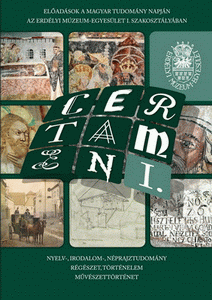Körösfői-Kriesch Aladár: "Engem Kolozsvárhoz annyi személyes, drága szál fűz..."
Aladár Körösfői-Kriesch: “I Have So Many Personal and Precious Ties with Kolozsvár…”
Author(s): Jenő MurádinSubject(s): Cultural history
Published by: Erdélyi Múzeum-Egyesület
Keywords: Abt family; artist colony from Stremţ; artist colony from Gödöllő; Kalota region; Cluj (Kolozsvár); Károly Kós; Aladár Körösfői Kriesch; Art Nouveau painting
Summary/Abstract: The career of Aladár Körösfői-Kriesch (1863–1920) painter, graphic artist and industrial artist is closely linked to the foundation of Gödöllő Colony of Artists. The founder of the colony was born 150 years ago leaving behind a vast work that extended to the other regions of the Carpathian Basin. The exploration of folk art in Kalotaszeg and Torockó, the source regions of secession, would not be complete without his work. His creative work in Transylvania was outstanding. He is the author of the painting entitled Dávid Ferenc, imposing in size, a symbolic work of the declaration of freedom of religion in Transylvania which can be seen in the local museum of Torda (Turda) nowadays. He worked on the mural paintings of the House of Culture in Marosvásárhely (Târgu Mureș), the former Seminary in Temesvár (Timișoara) and the altar-pieces in the Roman-Catholic monument church in Tövis (Teiuș). These works are dealt with in separate studies. Present work is trying to reveal those details in the artist`s early career that are linked to Kolozsvár (Cluj). From the beginning of the 1880s Aladár Kriesch (he took the surname Körösfői later on) worked in Kolozsvár, staying at his uncle‘s, Antal Abt university teacher and renting ateliers by himself for many times. These ateliers were the scene where the paintings ordered by the university of Kolozsvár were painted: the painting Franz Joseph exhibited in the university assembly hall, the portraits of Ágoston Trefort, Lajos Haynald, Antal Abt, as well as Károly Szabó, the learned librarian, which was luckily preserved in the store-house of the Art Gallery of Cluj. We could also find in the store-house his large painting entitled Templomozás Kalotaszegen (Going to church in Kalotaszeg ) (1905), which was not exhibited for many decades. The relationship between Aladár Körösfői-Kriesch and Károly Kós was hardly known until now, which is also accentuated in this study.
Journal: Certamen
- Issue Year: 2013
- Issue No: I
- Page Range: 460-474
- Page Count: 15
- Language: Hungarian

